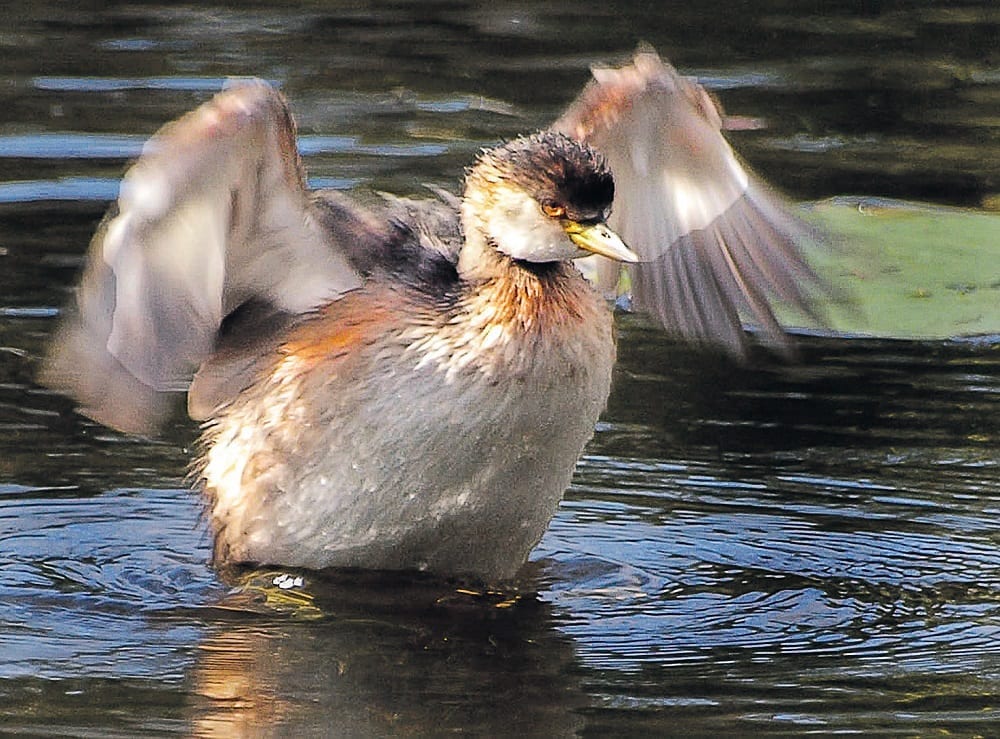Tags: Australian Wildlife. Queensland. Brisbane. Birds
By Marj Webber

Last week I spent a couple of hours in the serenity of the hide at Buckley’s Hole. There were lots of birds scattered around the far banks but only a few species were feeding in close proximity of the hide. Two Australasian Grebes came closer and closer, diving all the while to find food beneath the water. One was in breeding plumage and the other was not and I was able to take a few shots of each one.

Chick eating a red dragonfly caught by the parent
Australasian Grebes are very common breeding residents on Bribie Island working in pairs or in small groups. They live in freshwater lakes and wetlands and are almost always able to be seen at Buckley’s Hole and Bibimulya Wetlands. They are found throughout Australia where there are lakes, rivers and dams and also inhabit the Pacific Islands, and have introduced themselves to New Zealand.

Non-breeding plumage
Australasian Grebes are the smallest of the three species of Grebes in Australia with males and females being of similar in appearance. Males are usually a little larger than the females being 23 – 26 cm with a wingspan of about 39 cm, weigh 100 – 230 g and a lifespan of 11 – 12 years. Their plumage is waterproof and tail feathers are often fluffed and spread out when swimming to attract the warmth of the sun. When in breeding plumage the feathers become much darker with a rufous stripe down the side of the head and neck and a yellow patch appears behind the bill.

Nest with eggs starting to turn brown
Hoary-headed Grebes are of similar appearance. Buckley’s Hole has had only three recorded visits from Hoary-headed Grebes which not normally found in our area. Most of the day is spent looking for food by diving and finding small fish, crabs and water insects. Aquatic grass seeds are also on the menu. Australasian Grebes will sometimes eat their own feathers and feed them to the chicks. This is thought to prevent injury from sharp fish bones that have been eaten.

Chick riding on parent’s back
If the food supply is sufficient the grebes will usually stay at their normal feeding grounds and only move if the water dries up and food becomes scarce. I have often observed the small grebes following other waterbirds such as Grey Teal and Hardheads and diving together when searching for food. The grebes eat some of the prey that has been disturbed by their host. September to April is their most likely breeding season.
They build a platform of aquatic vegetation on the water which is normally anchored to something under the water. Sometimes two females lay the 4 – 7 bluish eggs in the finished nest. After a time these eggs are stained a dark brown by the vegetation in the nest. Eggs are incubated by both male and female for 23 days and both parents care for the young when hatched.

Grebe on nest
Chicks can swim as soon as they are hatched but often hitch a ride on their parents’ backs. Parents feed their chicks for about 10 weeks and when they start breeding again they are driven away. Up to three broods are produced in a season. When in danger grebes usually dive under the water to escape their prey. Other times they will hide amongst the vegetation with only the head protruding.
Conservation status is widespread and common. Artificial waterways created in parks and farmlands have been of benefit to their survival. There are no major predators threatening the species.
Other Articles
https://thebribieislander.com.au/double-barred-finch-wildlife-birds-australia/
